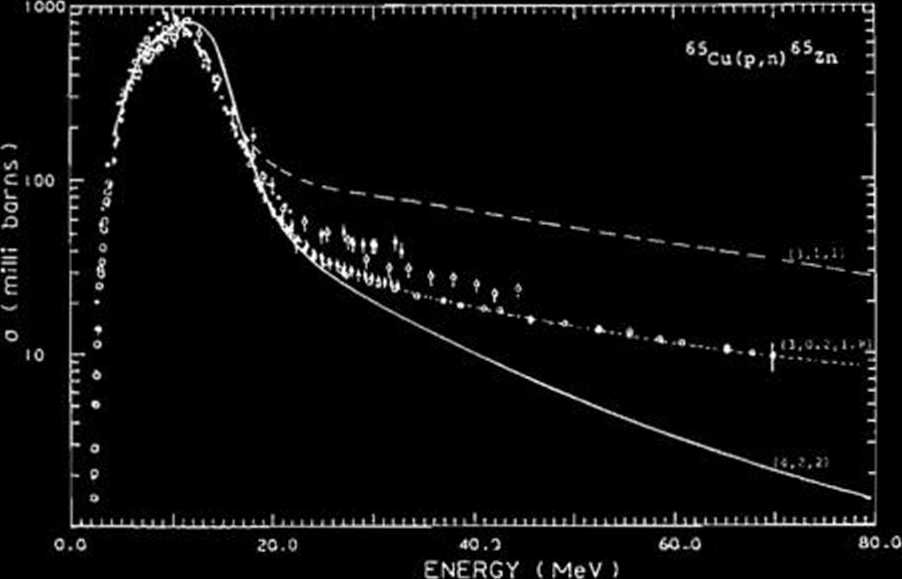372596160
132
RIKEN Accel. Próg. Rep. 24 (1990)
IV-5. Cross Sections Calculated by an ALICE Codę
in the A = 50 — 60 Region
A. Hashizume, Y. Tendow, and K. Kitao
In Order to know the applicability of a hybrid model to the calculations of cross sections in-duced by charged particie reactions, an Alice Livermore codę was tested in the mass region A = 50 —67, and the results were compared with experiment. The purposes of these calculations are to obtain the best combination of parameters to reproduce experimental results and to know the limit of its reproducibilities. Calculations were performed with a FACOM M780 Computer. In this mass region, several attempts have been madę to analyze excitation functions; however, it was sometimes difficult to fit calculated results to experiment.
In this study, p, d, 3He, and ^-particles were chosen as incident ions. The calculations of cross sections were madę for 41 targets in the energy region up to 100MeV of incident particles. Exper-imental data were collected from the literaturę. When data were given only by figures, we got numerical data from the figures with an aid of a digitizer.
In the reactions which follow complete com-pound reactions, absolute peak values and peak widths can reproduce the experimental results fairly well for p or ^-particie incident. However, in the energy region where a pre-compound pro-cess is dominant, the results of calculation depend sensitively on the number of excitons, and can hardly reproduce the absolute value and slope of curves of experimental results. It should be pointed out that the energy spectra of emis-sion particles are needed to decide the number of initial excitons. In Fig. 1, the results of calculations on the 65Cu(p, n)65Zn reactions are shown. Experimental data are taken from Ref. 1. The results of 54Fe(p, p2n)52Fe and 65Cu(^, 2n)67Ga are shown in Fig. 2 and 3, respectively.
For d- and 3He-induced reactions, it is difficult to deduce generał conclusion because less experi-mental results have been reported than those for p or a-particle induced reactions. In addition, large discrepancies between calculation and experiment were observed in some reactions. Calculations for parameter search are still performing for these reactions.
(p.p2n)

£n£ ^GY < MvV)
Fig. 2. Excitation function of 54Fe(p, p2n)S2Fe and the calculated curve.

Fig. 1. Excitation function of 6SCu(p, n)b5Zn reaction. The number of exciton is shown by a symbol (au (k> a*), where ax is the initial exciton number, (h is the initial excited neutron number and a* is the initial excited proton number.

Fig. 3. Excitation function of 65Cu(a\ 2n)67Ga and the calculated curves.
References
1) A. Hashizume, Y. Tendow, Y. Ohkubo, and K. Kitao: RIKEN Accel. Próg. Rep., 21, 186 (1987).
Wyszukiwarka
Podobne podstrony:
129 RIKEN Accel. Próg. Rep. 24 (1990)IV-2. Cross Section Data for 68Ge ProductionY. Tendow, A. Hashi
129 RIKEN Accel. Próg. Rep. 24 (1990)IV-2. Cross Section Data for 68Ge ProductionY. Tendow, A. Hashi
110 RIKEN Accel. Próg. Rep. 24 (1990)111-5-14. Test for Dispersive-Mode Beam Transportto the SMART
92 RIKEN Accel. Próg. Rep. 24 (1990)111-5. Instrumentation1. Design of a Microbeamline for a Compact
94 RIKEN Accel. Próg. Rep. 24 (1990)111-5-2. Design of a Decay Muon Channel Using an Axially Symmetr
102 RIKEN Accel Próg. Rep. 24 (1990)111-5-8. Performance of Isotopic Separation in RIPS T.Nakamura,
103 RIKEN Accel. Próg. Rep. 24 (1990)111-5-9. Test Experiment of the GARIS/IGISOL K. Morita, T. Nomu
105 RIKEN Accel. Próg. Rep. 24 (1990)111-5-10. Velocity Distribution of IGISOL lon Beams M. Koizumi,
108 RIKEN Accel. Próg. Rep. 24 (1990)111-5-12. Status Report of the RIKEN Swinger-Magnetic Analyzer
116 RIKEN Accel. Próg. Rep. 24 (1990)111-5-19. Responses of Large Position-Sensitive Detectorsto Hea
121 RIKEN Accel. Próg. Rep. 24 (1990)IM-5-23. A Test for SMART Neutron Detectors H. Orihara, K. Hata
RIKEN Accel. Próg. Rep. 24 (1990)111-5-25. High Speed Serial Data Link for PC-9801 J. Fujita > PC
133 RIKEN Accel. Próg. Rep. 24 (1990)V. DEVELOPMENT OF ACCELERATOR FACILITIES1. lon Accelerator Deve
138 RIKEN Accel. Próg. Rep. 24 (1990)V-l-4. RIKEN (Japan)-RAL (U.K.) Collaboration on Muon Science R
5 RIKEN Accel. Próg. Rep. 24 (1990)11-2. RILAC Operation Y. Chiba, M. Hemmi, M. Yanokura, M. Kasę, E
158 RIKEN Accel. Próg. Rep. 24 (1990)V-2-ll. Bump Magnet of SPring-8 H. Miyade, H. Takebe, and S. Mo
160 RIKEN Accel. Próg. Rep. 24 (1990)V-2-12. Measurement of a 508 MHz Model Coupler forthe SPring-8
więcej podobnych podstron